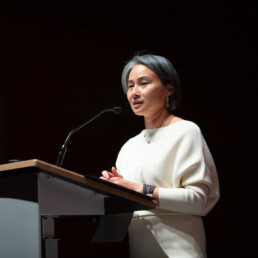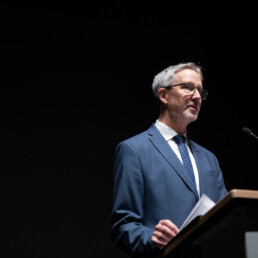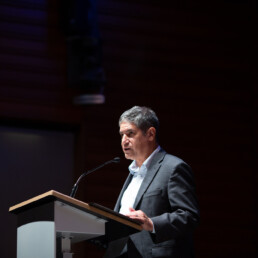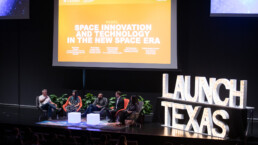By Nat Levy
Started last fall, Launch Texas aims to give students the entrepreneurial education needed to create their own space tech companies and serve as a hub for Texas space innovation, bringing together the aerospace community, academia and VCs.
Hailey Nichols is part of a new movement of entrepreneurial engineers coming out of the Cockrell School of Engineering. She built her path to a master’s degree while launching a startup company, Locus Lock. Last summer she received her M.S. in aerospace engineering and transitioned to a full-time role as founder of Locus Lock, a startup spun out of the Radionavigation Lab of aerospace engineering professor Todd Humphreys. Locus Lock makes a next-generation GPS receiver that provides high-integrity positioning solutions for customers globally.

Hailey NIchols, Locus Lock
To get to this point, Nichols created her own a la carte
educational path focused on both engineering and entrepreneurship. In addition to core aerospace engineering classes, her coursework also included both law and business offerings.
Nichols helped mentor eight master’s and Ph.D. students in the inaugural cohort of the Launch Texas program that started last fall. A collaboration between the Department of Aerospace Engineering and Engineering Mechanics and the Texas Innovation Center, Launch Texas aims to give students a well-rounded education with aerospace engineering and entrepreneurship components. The goal is to encourage students to start their own space tech companies, get involved with the startup scene, or join a large space tech company.
I am a trained engineer, so having the Texas Innovation Center and Launch Texas to support engineers dipping their toes into entrepreneurship, learning more about what that looks like in practice and getting advice from industry experts is valuable,
Nichols said.
Launch Texas is a multi-pronged effort. The first is the educational component. The second focuses on facilities and tech tools that allow students, faculty and researchers to build and refine their ideas. And the third involves creating relationships with venture capitalists and companies to help students get comfortable with the core components of funding and growing startups.
Leaders of the effort envision Launch Texas as the catalyst that brings together academia, the startup community and industry to create an ecosystem of aerospace innovation in Austin, the same way that Stanford University was instrumental in galvanizing the tech boom around the San Francisco Bay Area.
“We want to stand up a program that works together with the greater Austin and Texas aerospace communities to eventually help build the Silicon Valley of space right here in our backyard.”
—Van Truskett, executive director of the Texas Innovation Center



From left to right: Truskett, aerospace engineering professors and Launch Texas leaders Clint Dawson and Noel Clemens.
Space Central
Texas has for decades been associated with aerospace. The Johnson Space Center in Houston is perhaps the most famous example. It’s the epicenter of the Texas space community, serving as a primary NASA location for training, research and flight control for more than half a century.
But over time, the Texas space industry has started to spread out, and Austin is reaping the benefits. The Department of Aerospace Engineering and Engineering Mechanics is among the 10 best programs in the country for both graduates and undergraduates.
The Austin area is home to several promising startups such as rocket maker Firefly Aerospace, which has already partnered with the Cockrell School of Engineering and the Texas Rocket Engineering Lab, and Icon, a 3D-printing company that is working on structures for astronauts exploring the moon.
Perhaps the biggest recent development in Austin’s evolution as a burgeoning aerospace hub was the news that SpaceX is planning a major facility in the area. It’s a sign that the city is becoming a major draw not just for tech companies but also aerospace.
Once you have that critical mass, then that breeds other companies that start here or want to move here from other places,
said Clint Dawson, professor and chair of the Department of Aerospace Engineering and Engineering Mechanics.

Alexander Nettekoven, Multi AI
A New Kind of Aerospace Engineer
Aerospace engineering students have long been prepared to work at large government organizations like NASA or some of the bigger aerospace companies, such as Lockheed Martin and Boeing. Through Launch Texas, students will gain the tools to join space startups or even create their own companies.
Launch Texas is supporting a new space tech graduate specialization for master’s and doctoral students comprising topics in aerospace and technology, infused with a solid foundation in business and entrepreneurship. Students get hands-on practice in business formation and engagement with successful space tech entrepreneurs. The program recruits mission-driven student entrepreneurs from across UT Austin, the state, the nation and the world.
We want to train students so they have all the engineering fundamentals, but also have some business skills and the skills to present themselves to venture capitalists and the public to sell their ideas,
Dawson said.
As part of that, the program plans to bring in local space entrepreneurs and investors to help students get ready to enter into that orbit. Students who have learned about the business side before the creation of Launch Texas will help out as well.
Alexander Nettekoven completed his Ph.D. work at UT Austin late last year. He is the CEO of the startup Multi AI, which focuses on strategic decision making for autonomous vehicles, such as drones, satellites and ground robots.
When building their companies, both Nichols and Nettekoven worked closely with the Texas Innovation Center to learn the fundamentals of commercialization. Leaders from both startups have participated in and won pitch contests.
This gives them invaluable knowledge about the process, learning how to talk to investors and deliver winning pitches. This experience has been crucial for student entrepreneurs like Nettekoven, and bringing all of that together as part of an academic program will help the next generation get their feet under them. And they are paying it forward by continuing to mentor students in the Launch Texas program.
Having a program where students, faculty and industry come together helps people understand all the elements involved with creating a startup,
Nettekoven said. It can help narrow the gap between what is going on with the research side and what is happening in the industry.

Students meeting Bob Smith, CEO Blue Origin of Cockrell School alumnus.
A Place to Innovate and Collaborate
In a lot of ways, aerospace is unlike other engineering disciplines. Aerospace engineers build big, massively expensive things — rockets, satellites, etc. Naturally, Launch Texas is pursuing private funds to build facilities that would give students a place to work on projects that will someday become startups.
But it wouldn’t be just for students and faculty. The facilities would be open to local entrepreneurs to build prototypes that will help them grow their companies.
Having such a space would be unique and truly enabling of innovation in space tech,
said Noel Clemens, a professor in the Department of Aerospace Engineering and Engineering Mechanics and one of the leaders of Launch Texas. It can be an important reason for new startups to establish themselves in Austin.

A panel discussion at the Launch Texas kickoff event. Panelists (left to right): LIFT Aircraft CEO Matt Chasen; aerospace architect Phnam Bagley; Capella Space CEO Payam Banazadeh; aerospace engineering professor Todd Humphreys; and Space Fund3 co-founder Meagan Murphy Crawford.
The Next Silicon Valley?
Big tech cities like San Francisco, New York and Los Angeles built up strong innovation ecosystems. These hubs run well when every player in the ecosystem of creating and growing companies works together. That includes academia, where all the deep tech discovery that enables these startups happens. And it also includes the big companies in the area, venture capital firms and accelerators and incubators designed to help companies grow.
Andrew Kirima sees this type of synergy developing in Austin. He is an analyst for Cantos, a VC firm based in San Francisco that invests in the near frontier, an Austin resident and a mentor at the Texas Innovation Center.
Cantos has invested in several aerospace startups, one of which is Texas-based company Venus Aerospace. Kirima noted the culmination of government funding from wartime incentives married with a shifting tax environment created a high-risk, long-tail venture finance model. Venture capital was initially formed to proliferate advanced technology in the aerospace industry. Finance coupled with abundant technical talent from Stanford, would give birth to Silicon Valley.
Austin’s innovation ecosystem is cultivating a similar zeitgeist,
Kirima said. And the city has all the right ingredients to be at the pinnacle of space innovation: A top-ranked aerospace department for students and research; burgeoning space tech industry; growing investor community; and strong support from state and local government.
A look at the growth of the Department of Aerospace Engineering and Engineering Mechanics and the new space race.

Get Involved
Launch Texas is just getting started. Building a space ecosystem takes time and investment. And we are calling on our community to get involved, whether that’s through gifts or volunteering to speak about your own experiences of entrepreneurship. For more information, contact Johnson Carpenter at johnson.carpenter@austin.utexas.edu.
Launch Texas is also looking for the next cohort of students. Though the first group is made of master’s and Ph.D. students, Launch Texas would also like undergraduate seniors to get involved. For more information, visit ae.utexas.edu/launch-texas.